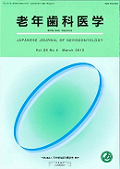All issues

Volume 29, Issue 2
Displaying 1-4 of 4 articles from this issue
- |<
- <
- 1
- >
- >|
Original Articles
-
Koji Hara, Haruka Tohara, Izumi Kondo, Eiichi Saito , Takashi Higasigu ...2014Volume 29Issue 2 Pages 57-65
Published: October 16, 2014
Released on J-STAGE: October 25, 2014
JOURNAL FREE ACCESSPercutaneous endoscopic gastrostomy need easy operation, and gastrostomy is useful enteral nutrition for dysphagic patients. Although the guidelines for the application of PEG are established, there are no guidelines for the resumption of oral ingestion for patients with PEG or removal PEG. Our aim was to investigate the body function and eating status of convalescing patients after stroke with gastrostomy by multiple centers. 133 patients (men 72, women 61) were enrolled (mean age were 77.1±11.3). We investigated the patientsʼ basic data, Japan Coma Scale;JCS, cognitive function, Activities of daily living;ADL, oral hygiene, the presence of dysarthria and dysphonia, the presence of tracheostomy, the Eating Status Scale; ESS at the investigation (the ESS pre-Videoendoscopic evaluation of swallowing; VE), the presence of aspiration by VE and the desirable ESS by the result of VE (the ESS post-VE). 61.3% of the patients lived in their home or nursing home. The cognition and ADL of most patients were poor, but more than half of them showed favorable oral hygiene. There were many patients with dysarthria and dysphonia. 82.7% of 110 patients were evaluated as non-aspiration by VE. There was a significant difference between the ESS pre-VE and the ESS post-VE (p<0.01). The present study showed the importance of swallowing evaluation for convalescing patients with gastrostomy after discharge from hospital.View full abstractDownload PDF (1383K) -
Masumi Muramatsu, Shingo Moriya2014Volume 29Issue 2 Pages 66-76
Published: October 16, 2014
Released on J-STAGE: October 25, 2014
JOURNAL FREE ACCESSThe objective of this study is to describe oral care nursing practices among care providers at three type of long-term care facilities in Japan. The subjects were nursing supervisors and the survey was conducted with a mailed anonymous self-response questionnaire. We sent the questionnaires to 2,947 facilities by mail, and subsequently 800 facilities completed and returned them, which yielded a 27.1% collection rate. Seven hundred forty valid responses, 25.1% of the 2,947 questionaries, were analyzed. The results showed:the positive response for " is oral hygiene care one of the qualityʼs indicators used by Virginia Henderson?" was 80.4%;there was insufficient education for nurses, nursing assistants, certified care workers and caregivers, less than 20% of the long-term care facilities used an oral assessment;less than half of the long-term care facilities had an oral care nursing procedure. More than 90% of the long-term care facilities had cooperated with dental professionals, but only 40.3% of the long-term care facilities had calculated the oral function maintenance system points and 15.7% had calculated the oral function maintenance points. Comparing the results among 3 types of long-term care facilities, medical long-term care Sanatoriums had a higher percentage of standardized nursing oral care procedures because more nurses were employed than the other facilities, and they provided oral care. The challenge of nursing management practices for oral care in the future is to improve the education system for facility staff including nurses and other care workers, create an oral assessment and nursing procedures for oral care, and improve co-operation with dental professionals.View full abstractDownload PDF (1442K)
Reports on Survey
-
Yumi Hamamoto, Takuya Kihara, Sumiyo Mimura, Hiroshi Kumagai, Tsuyoshi ...2014Volume 29Issue 2 Pages 77-83
Published: October 16, 2014
Released on J-STAGE: October 25, 2014
JOURNAL FREE ACCESSAccompanying the increase in the elderly population, aspiration pneumonia has been considered to be one of the most serious diseases for the elderly. It is necessary that the texture of foods for the elderly should be adapted to the levels of disorders of oral functions or swallowing, to decrease the risk of aspiration pneumonia. Currently, thickening agents which add appropriate thickness to liquid foods and drinks are used extensively to decrease the risk of aspiration. However, adequate physical property analysis has not yet been performed. Hence in the present study, the effects of concentration of thickener, tastes and temperature on the textures and syneresis of the thickening agent for preparation of swallowing food were evaluated. Samples containing different concentrations of thickener were prepared to regulate the amount of the thickening agent. Samples containing the different tastes were prepared to add sweet, salty and acid taste to the solvent. Each sample was regulated under the different temperatures (5℃, 25℃ and 37℃, respectively) and their textures were analyzed to calculate hardness,cohesiveness and adhesiveness. The syneresis was calculated to measure the weight of the filter paper drawing moisture out of the surface of the thickening agent. From the results of texture analysis, the hardness, cohesiveness and adhesiveness of the food was classified by means of the swallowing food pyramid, regardless of changes in concentration and temperature. The physical properties of the thickening agent hardly change as a result of concentration and temperature. However, the thickening agent with added salty and acid taste might cause difficulty. Higher syneresis was observed with the sample with citric acid. This result suggests that the adding of an acid taste to the thickening agent causes unexpected changes in its textures.View full abstractDownload PDF (719K)
Abstracts
-
Japanese Society of Gerodontology2014Volume 29Issue 2 Pages 84-247
Published: September 30, 2014
Released on J-STAGE: June 26, 2023
JOURNAL FREE ACCESSDownload PDF (4317K)
- |<
- <
- 1
- >
- >|